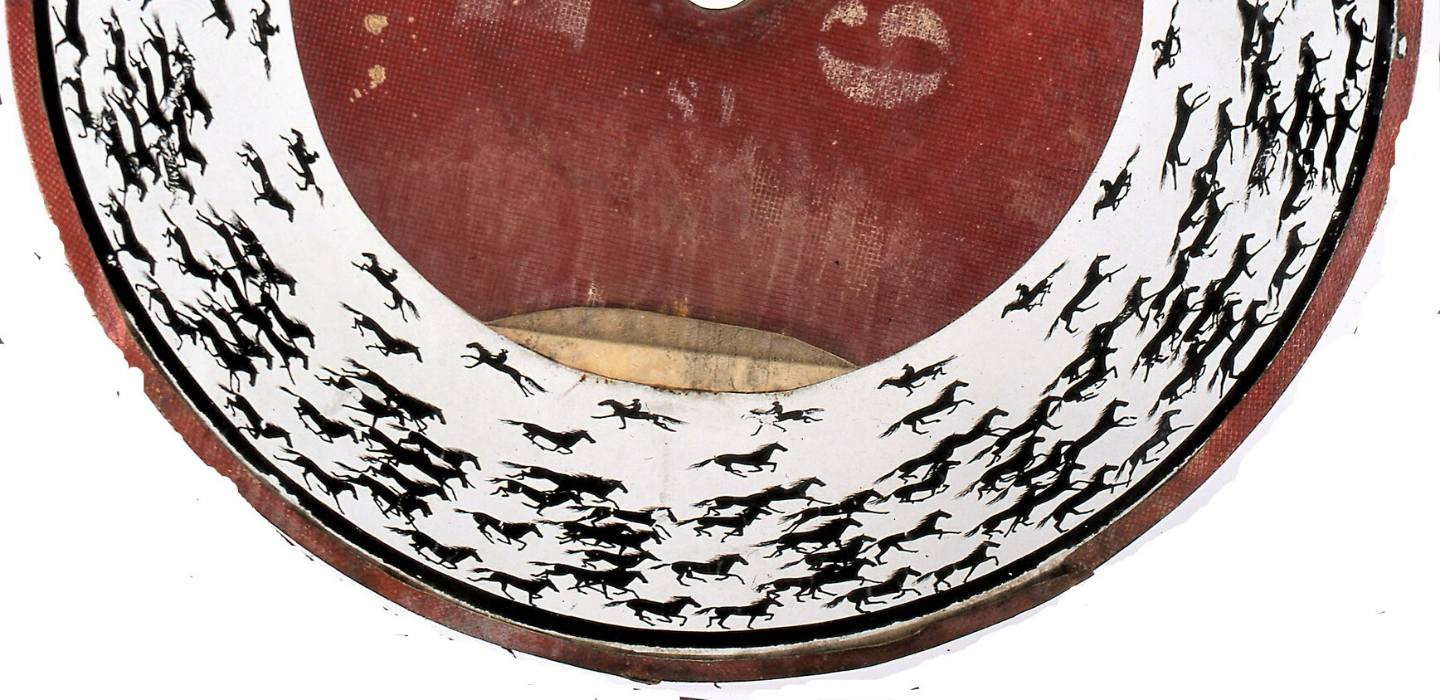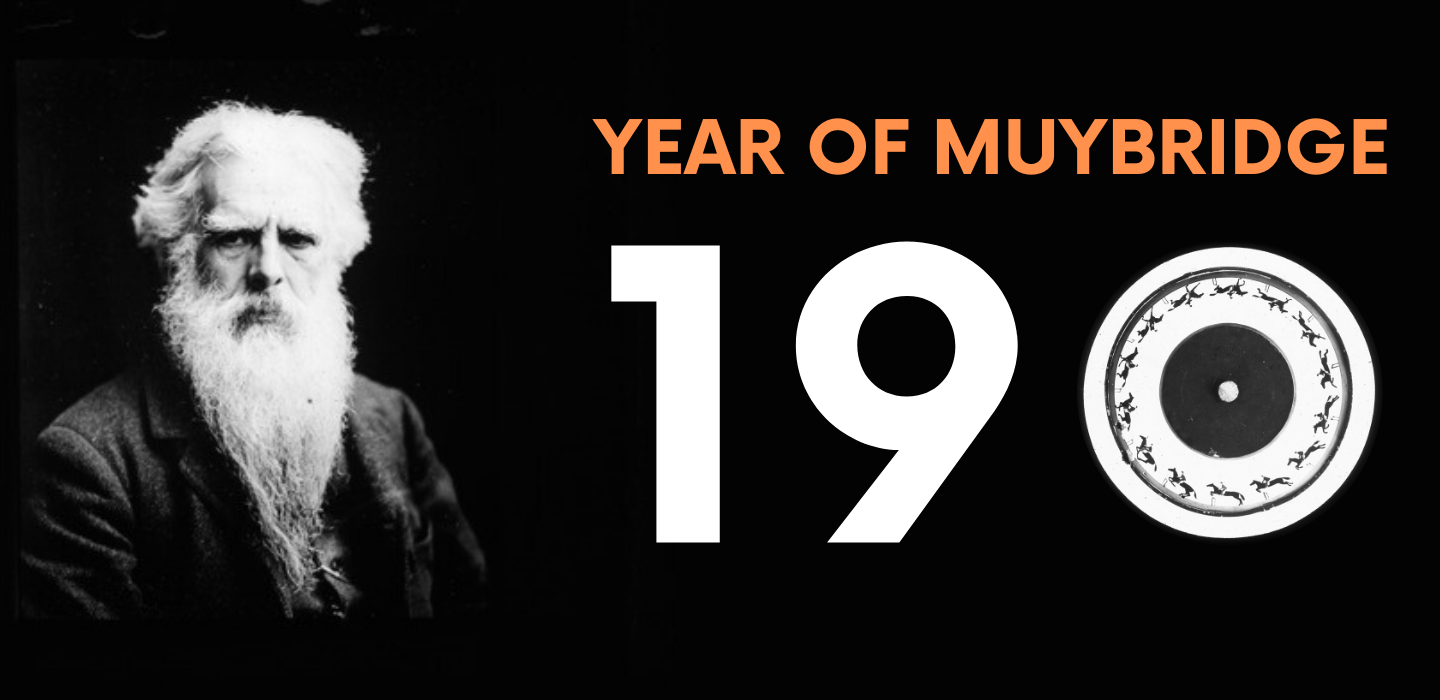Eadweard Muybridge (1830-1904)
Kingston Museum is fortunate to hold Eadweard Muybridge's personal collection, which the photographer bequeathed to the museum in 1904. The Muybridge Collection consists of around 2,500 glass lantern slides, 67 unique glass zoopraxiscope discs, a rare panorama of San Francisco taken in 1878, over 150 collotype prints, and equipment used by Muybridge during lectures he gave while touring the United States and Europe in the 1880s and 1890s. His collection is a must-see for visitors, especially those with an interest in art, science, or entertainment. Key objects include:
- The only original zoopraxiscope Muybridge invented and used during his famous lectures
- Unique zoopraxiscope discs Muybridge used to create motion pictures
- Muybridge's carrying case
- The 1878 San Francisco panorama
- Lantern slides from Muybridge's travels in the Americas, and his human and animal locomotion studies
Kingston Museum’s Muybridge Collection is of international importance to scholars. Eadweard Muybridge influenced people as diverse as Thomas Edison, Marcel Duchamp, Francis Bacon and Philip Glass and he was a pioneer of the many forms of visual entertainment we enjoy today.
Muybridge’s Life and Career
In 1830 Muybridge was born in Kingston upon Thames. His real name was Edward Muggeridge and his family were grain and coal merchants. Aged 20, he emigrated to the United States to work as a bookseller. Muybridge took up photography after receiving a head injury during a stagecoach accident in 1860. Around this time, he changed his name to Eadweard
In 1830 Muybridge was born in Kingston upon Thames. His real name was Edward Muggeridge and his family were grain and coal merchants. Aged 20, he emigrated to the United States to work as a bookseller. After receiving a head injury during a stagecoach accident in 1860, Muybridge spent several years in the UK to recover. It is unknown when Muybridge took up photography, but he became an accomplished photographer soon after his return to America in 1866.
Muybridge later changed his name to Eadweard, likely influenced by the Anglo-Saxon King of his native Kingston.
Photographing the US and Central America
Muybridge initially focused on landscape photography of the undiscovered American West, capturing scenes of what would become Yosemite National Park. He travelled to Alaska shortly after its purchase by the United States and took rare photographs of the native Tlingit people. Muybridge also made a nine-month trip to Central America for a commissioned assignment and took hundreds of the stunning photographs of local landscapes and people.
Muybridge mastered the challenging technique of splicing multiple photographs to create a larger image and produced the 1878 San Francisco panorama in the collection.
Innovations and inventions
Photographic processes were hands-on during the 1800s. Exposure times were long, equipment heavy, and photographic plates made of glass, but Muybridge was inventive and innovative. To capture the first action shots of a galloping horse, he used multiple cameras in different positions. Their shutters were triggered by electricity, enabling a shutter speed of one thousandth of a second.
One of Muybridge’s major inventions was the zoopraxiscope, a forerunner of the moving picture projector. The zoopraxiscope consisted of a magic lantern projector holding a moving glass disc painted with images adapted from Muybridge's motion studies. As the disc spun within the zoopraxiscope, a moving image was projected on the wall.
Animal Locomotion
Leland Stanford, railroad tycoon and governor of California, hired Muybridge and challenged him to take photographs of a horse in motion. In 1878 this led Muybridge to produce his most famous images, a series of successive photographs capturing a horse moving at speed. These pictures proved for the first time that a horse lifts all its legs off the ground simultaneously when galloping. No artist had been able to accurately depict this, as it is too fast for the naked eye to see.
In 1884 he resumed the project at the University of Pennsylvania photographing men, women and children performing different physical activities. He also made motion studies of animals, including elephants and birds in flight. These series of photographs were the subject of his 1887 multi volume publication ‘Animal Locomotion’.
‘Justifiable’ Homicide
Aside from his photographic pursuits, Muybridge was caught up in one of the most sensational criminal trials of the 1870s. In 1872 he married a much younger woman, Flora Shallcross Stone, and they had a son, Florado. However, Muybridge discovered that Flora was having an affair with a man called Harry Larkyns. Perhaps Florado was not Muybridge’s son after all? Devastated by this discovery, Muybridge shot Larkyns point-blank in the chest and killed him. After a harrowing murder trial, the jury gave a verdict of ‘justifiable homicide’ and Muybridge walked free. Sadly, following Flora’s death in 1875, he gave Florado up for adoption.
Return to Kingston
During the 1893 Chicago Columbian Exposition, Muybridge showcased his work in the specially constructed Zoopraxographical Hall. However, his zoopraxiscope had been overtaken by newer technologies, and disappointingly his exhibit was one of the worst-performing of the entire fair. Muybridge moved back to Kingston in 1894. Apart from a trip to America to settle his affairs, he remained in the area until his death in 1904.
During this time Muybridge became good friends with Borough Librarian Benjamin Carter. This probably influenced his decision to leave his collection to Kingston Museum, which was built next to Kingston Library, opening five months after Muybridge’s death.
Further Information
Eadweard Muybridge: Defining Modernities. This website was created as a joint project between Kingston Museum and Kingston University
Muybridge and the Time Travelling Camera
As part of Year of Muybridge we collaborated with Tim Wheatley to create Muybridge and the Time Travelling Camera, a short animated film suitable for all the family!


